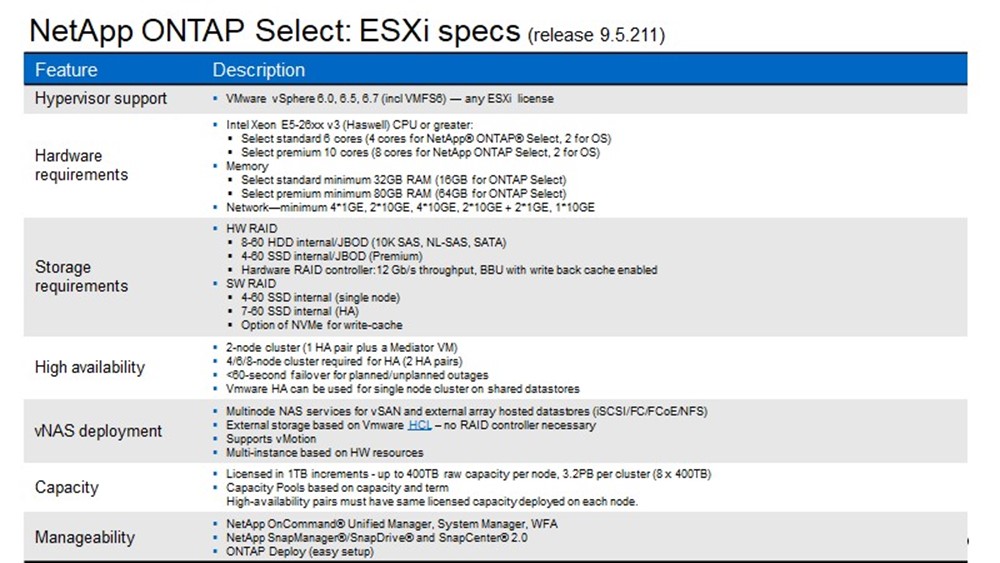“NetApp ONTAP Select is the software-defined version of ONTAP deployed on customers’ choice of commodity servers and hypervisors.”
First, I must introduce NetApp ONTAP Select a Software Defined Storage play allowing for ONTAP to be leveraged on commodity hardware and not requiring FAS hardware. Before Select, NetApp had released a product called ONTAP Edge a similar use case but limited to VMware.
Edge was great for me from a test and development point of view, I didn’t have the power or budget to be able to run a full blown FAS in my home lab, so Edge gave me that possibility rather than relying on what has become a flaky at best ONTAP simulator. The biggest let down though was it was only available for vSphere as an OVA format appliance. More to come on this later.
This is not a release post in fact ONTAP Select has been round for some time, maybe 3 years. But I think now is the time it should be taken seriously in the world of Software-Defined Storage but also how it interacts with the whole NetApp Data Fabric.
Back to ONTAP Select, the key benefits to this new SDS platform are the following:

Flexibility and Agile – the ability to deploy “Cloud Like” storage on commodity server infrastructure. To be able to deploy, expand and procure in a very fast and efficient way.
Enterprise Availability – Ultimately this solution is running ONTAP this means all the rich management features and tools are also baked into this product. Something that ONTAP Edge didn’t have and was lacking was the ability to provide high availability across multiple ONTAP Select nodes. More on this later also.
Efficient and Effective Protection – As I said previously this is using the ONTAP system so all the Snapshot, SnapMirror and SnapVault technologies are also available here, but also the storage efficiencies are also ported over meaning space savings on commodity hardware.
High Availability
High availability is obviously important even in the Software Defined Storage space. ONTAP Select is supported in 1,2,3,4,6 and 8 node configurations. Obviously, there is little HA in the 1 node cluster. Let’s do the maths quickly there so 400TB RAW for each node, means we can get up to 3.2PB in a single cluster.
A FlexGroup could be used to merge all useable capacity into a single name space.

What we have here is a Software Defined Storage, Scale out solution with the same namespace across all four nodes. And with all the same benefits around non-disruptive operations. As with ONTAP we have the ability to still move workloads Non-disruptively between these nodes as well as rebalance that workload.
This solution today is scalable to 400TB RAW, but with all the benefits of storage efficiency around Thin Provisioning, deduplication and compression this makes for a great option on some of the following scenarios I am going to mention later.
It’s also worth mentioning that this will allow for a unified storage offering File level services in NFS and SMB as well as block with the iSCSI protocol.
Scenarios
Test & Development

Given the hardware requirements this scenario makes for a great use case for a Test and Development use case, the ability to send production volume data to an ONTAP Select node and then be able to use that in a development environment allowing developers to run against the ONTAP capabilities, obviously the downside here the ONTAP Select platform may not be as performant as the production FAS system but still there is a great number use cases within this scenario where this could really drive development within an enterprise business.
Tier 2 / 3 primary workloads

Because this is commodity hardware there is no real limitation on what hardware can be used (when I say this, I mean regarding the disk spindles or SSD that are used within the hardware) this means you are able to appropriately tier your production storage to leverage this easily adaptable platform as part of the enterprise storage solution.
DR / Offsite Secondary storage

Why do you need a like for like storage solution in your disaster recovery location when you can fill out some commodity hardware with disk and then have ONTAP Select on top accepting all SnapMirrored data appropriately? But also think for longer term retention and SnapVault, for longer retention possibly compliance rulings you can use this commodity hardware and storage rather than a full enterprise array for such retention. Surely cutting costs but still retaining the fabric enabling the transfer of data between sites and locations. I am going to get into this one in some more detail in another post.
Service Providers

The above scenario I mention is purely for private clouds, what about leveraging that same technology in a Service Provider environment and allow for Backup As A Service or even DR As A Service using ONTAP Select, this is going to be possible with all the built in isolation and multi tenancy capabilities of ONTAP 9.
Technical Requirements & Specification
The final thing I am going to touch on in this post is the NetApp ONTAP Select technical requirements.


To find out more visit NetApp.com and also for a free 90 day trial.
